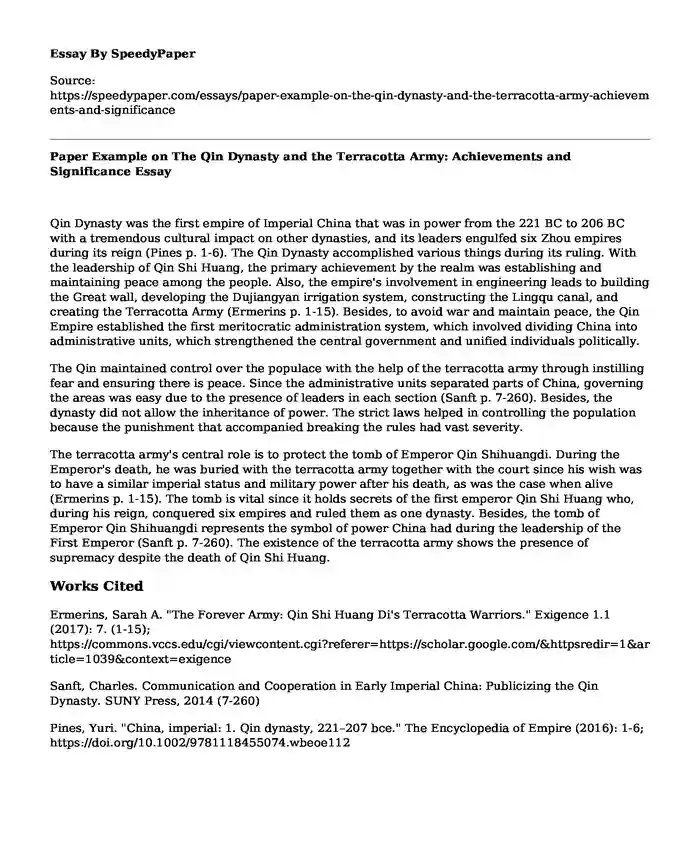Qin Dynasty was the first empire of Imperial China that was in power from the 221 BC to 206 BC with a tremendous cultural impact on other dynasties, and its leaders engulfed six Zhou empires during its reign (Pines p. 1-6). The Qin Dynasty accomplished various things during its ruling. With the leadership of Qin Shi Huang, the primary achievement by the realm was establishing and maintaining peace among the people. Also, the empire's involvement in engineering leads to building the Great wall, developing the Dujiangyan irrigation system, constructing the Lingqu canal, and creating the Terracotta Army (Ermerins p. 1-15). Besides, to avoid war and maintain peace, the Qin Empire established the first meritocratic administration system, which involved dividing China into administrative units, which strengthened the central government and unified individuals politically.
The Qin maintained control over the populace with the help of the terracotta army through instilling fear and ensuring there is peace. Since the administrative units separated parts of China, governing the areas was easy due to the presence of leaders in each section (Sanft p. 7-260). Besides, the dynasty did not allow the inheritance of power. The strict laws helped in controlling the population because the punishment that accompanied breaking the rules had vast severity.
The terracotta army's central role is to protect the tomb of Emperor Qin Shihuangdi. During the Emperor's death, he was buried with the terracotta army together with the court since his wish was to have a similar imperial status and military power after his death, as was the case when alive (Ermerins p. 1-15). The tomb is vital since it holds secrets of the first emperor Qin Shi Huang who, during his reign, conquered six empires and ruled them as one dynasty. Besides, the tomb of Emperor Qin Shihuangdi represents the symbol of power China had during the leadership of the First Emperor (Sanft p. 7-260). The existence of the terracotta army shows the presence of supremacy despite the death of Qin Shi Huang.
Works Cited
Ermerins, Sarah A. "The Forever Army: Qin Shi Huang Di's Terracotta Warriors." Exigence 1.1 (2017): 7. (1-15); https://commons.vccs.edu/cgi/viewcontent.cgi?referer=https://scholar.google.com/&httpsredir=1&article=1039&context=exigence
Sanft, Charles. Communication and Cooperation in Early Imperial China: Publicizing the Qin Dynasty. SUNY Press, 2014 (7-260)
Pines, Yuri. "China, imperial: 1. Qin dynasty, 221–207 bce." The Encyclopedia of Empire (2016): 1-6; https://doi.org/10.1002/9781118455074.wbeoe112
Cite this page
Paper Example on The Qin Dynasty and the Terracotta Army: Achievements and Significance. (2023, Oct 18). Retrieved from https://speedypaper.com/essays/paper-example-on-the-qin-dynasty-and-the-terracotta-army-achievements-and-significance
Request Removal
If you are the original author of this essay and no longer wish to have it published on the SpeedyPaper website, please click below to request its removal:
- Law Essay Sample Dedicated to the Fourth Amendment
- Conspirator - Movie Review Essay Example
- Free Essay: Should America Continue to Commemorate Its Confederate Past in Form of Public Statues
- Essay Example on Prisoners' Rights
- Essay Sample on Performance Management in the Public Sector, Non-Profit Sector, and Government
- Essay Sample on John Locke's View on Power and Government
- Leadership & Management: What's the Difference? - Essay Sample
Popular categories





